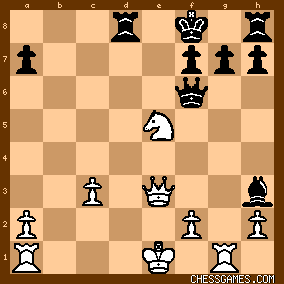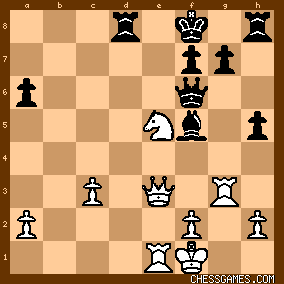| KEG: Lasker's fine winning move 22. Nc6! was a thing of beauty, but Lasker's play before then was surprisingly weak. The errors in this game were (except for Mieses' final losing move--21...a6?) entirely missed by Rosenthal in the Tournament Book and by Marco in his analysis of this game. With 7. e4, Lasker obtained an open and clearly superior position against Mieses' Semi-Tarrasch Defense. Mieses could nonetheless have had a playable game with 7...Be7 as noted by Rosenthal. Mieses' 7...cxd4?, however, was a blunder. It is hard to see how Mieses could have survived had Lasker responded 8. Bb5+, a move neither Rosenthal nor Marco mention. By contrast, Lasker's 8. Qxd4? let Mieses back in the game. Mieses erred badly again with 12...Bb4, a move wrongly praised by Marco. After 13. BxN+ bxB, the simple 14. 0-0 would have given Lasker close to a won game. But Lasker (and Rosenthal and Marco) missed the power of 14. 0-0 and played 14. Qxc6+, and then got into trouble after 14...Kf8 15. Qe4? (15. Qb5 should have been played). After the ensuing exchanges, Lasker's pawn structure was fractured and his King was precariously placed. After 18...Bh6, Lasker's opening advantage was entirely gone, his King was under siege, and a dangerous pin on the e-file loomed: 
click for larger viewLasker's 20. Kf1 only made things worse (he needed to play 20. Qc5+). After 20...h5 21. Re1, Mieses definitely had the better game. But Mieses failed to play 21...g6 (Marco spotted this) and instead played 21...a6? The position was now as follows: 
click for larger viewNow Lasker pounced with the brilliant 22. Nc6! and suddenly the game was over. As previously noted on this site, Mieses' 22...Qxc6--though a losing move--was better than the alternatives. Mieses' 25...Qh1+ led to immediate disaster, but even with the "best" move (25...g6) Mieses was lost. Not one of Lasker's better games, but a lovely finish. | 




































